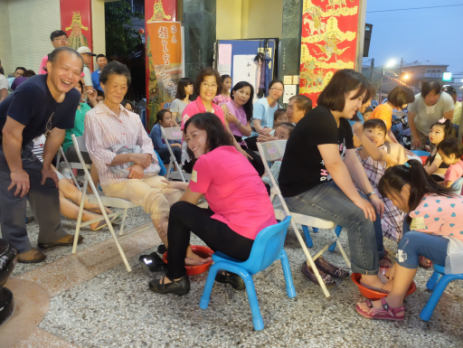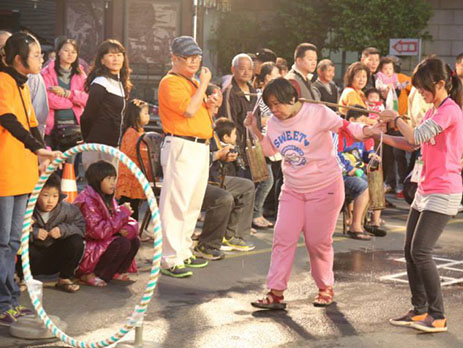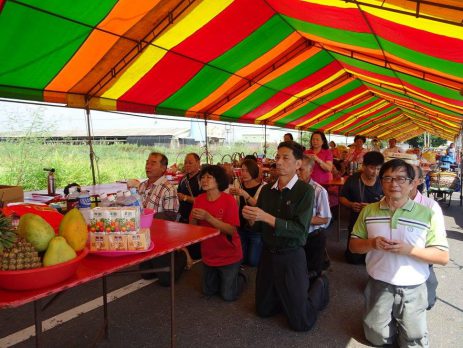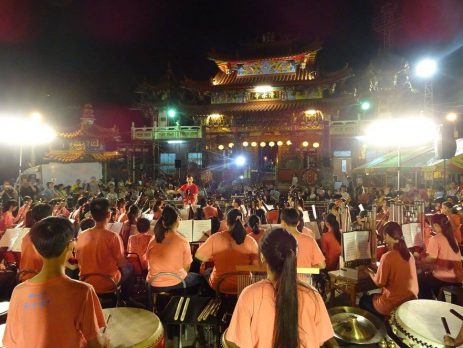Bi Hu Temple at Dahu has a long history of organizing pilgrimages with Bao An Temple at Sidingliao. Likewise, villages including Sidingliao, Jhongjhouliao, Waiwunzih, Old Heshun, Zongtouliao, Shihsandian, Budaizueiliao, and Jhengzihliao also have a close relationship with the Pao Sheng Emperor from Cih Ji Temple at Syuejia. The collaboration of Bi Hu Temple and Bao An Temple shows how local belief centers interact with one another. Another example is the tradition of the Pao Sheng Emperor from Syuejia going south on a tour of inspection in Jianzihpu, Taikang. These traditions had a significant influence on the formation of the settlement villages in Jianzihpu. During the pilgrimages, residents from different villages would take turns carrying the sacred palanquin. These frequent tours of inspection imperceptibly reinforced the local belief of the deity Dadaogong (a.k.a. the Pao Sheng Emperor), which later helped the “16 major villages” band together as a whole.
In Jianzihpu, there are a total of 12 villages that worship Dadaogong as their primary guardian deity. Thus, Pao Sheng Emperor can be seen as the patron deity of the Taikang settlers. The religious activities of local temples also helped stabilize the early settlements. To the pioneers in early days, a village was a place built up by fellow settlers. It was where they could live in peace and prosper, and thus was considered the most important social unit (besides family) in the Han Chinese communities in Taiwan. It was also a place where people could find a sense of belonging: residents in the same village worshipped the same deities and shared the same fate. In these villages, local temples were the center of communities and where residents conducted public affairs.
After 1823, religious spheres began to form in the villages of Taikang, and in different parts of Jianzihpu, settlers on the plain worshipped different deities from their hometowns respectively. For instance, settlers in Old Heshun, Jhongjhouliao, and Sisinliao came from Jhongjhoujhuang in Syuejia, so they worshipped Dadaogong. Settlers in Nanluliao came from Kaohsiung County, so they welcomed the division of the deity Dadaogong from the Cih Ji Temple at Weizihnei, Kaohsiung. In Shih-erdian, the Gao family came from Au-âng, so they worshipped the deity Divus Guan (the deified Guan Yu). The Yang family in Haiweiliao and New Heshun came from Fanzihliao in Jiali and worshipped the deity Erlang Shen. Every year, they’d go back to Fanzihliao to pay tribute to the original deity (from which they divided the local deity). The Su family from Sinwun in Haiwei and Matzu Temple (name of a village), on the other hand, went back to Sinwun in Budai Township to welcome the divisions of Duke Syufu and Duke Yinfu. The deities were later housed by turns by the Su family in the two villages. Chencingliao, Nanluliao, and New Heshun, which took turns housing the deity Sanjhuangtougong (meaning “Three Village Lord”), would go to the Cih Ji Temple at Weizihnei in Kaohsiung to pay tribute to the original deity. At the same time, in villages where the deity divisions came from the Cih Ji Temple at Syuejia, locals would invite the Pao Sheng Emperor from Syuejia to go south on a tour of inspection in Jianzihpu, Taikang when it was the time of Dadaogong’s birthday. In addition, the Fanzihliao Yang family in Haiweiliao and New Heshun would also go back to Ying Yuan Temple at Fanzihliao to pay tribute to the original deity when it’s the birthday of Erlang Shen.
*source:
Wu, Mao-cheng. Taikang Inner Sea and Its Villages. Tainan: Cultural Affairs Bureau, Tainan City Government, 2013. 342, 345-346, 350. Print.
“Veteran Kua-á-hì (Taiwanese folk opera)” – Tribute to the Haiwei Dadaogong
The “Veteran Kua-á-hì” at Haiwei’s Chao Huang Temple is a tradition that is more than a century old. Back when Taiwan was under Japanese rule, the colonial government conscripted a lot of Taiwanese men into the Imperial Army. Due to the fierce war, a lot of them did not survive. Thus, before their departure, the conscripted men would come to Chao Huang Temple and pray to the deity that if they could make it home, they would put on a kua-á-hì play in front of the temple as a token of appreciation. Even after Taiwan was retroceded to the Republic of China, the tradition lasted: those who reach the age of conscription would pray to Dadaogong for a safe return before leaving their hometown. Colorful ribbons will be put on these soldiers-to-be to wish them good luck and after they are discharged, these veterans would put on a kua-á-hì play in return to pay tribute to Dadaogong, recite a document of prayer and appreciation to the Jade Emperor (the supreme deity of Chinese tradition), and worship all the deities at Chao Huang Temple. By doing so, they express earnestly their gratitude and wish for a successful career and healthy life as they come back home and start out a new page of life. The tradition has been around for more than a century and is called the “Veteran Kua-á-hì” by local residents.
The event of “Veteran Kua-á-hì” at Chao Huang Temple is held on the 11th in the third month of the lunar calendar every year. It is not only a cultural heritage in the history of Taikang, but also a unique folk culture which blends local religious beliefs and an important life event (which is only present in Haiwei among all the 27 villages of Taikang). Through this event, visitors can appreciate the culture of Haiwei more closely and experience the religious rituals with local residents.
*source:
2017 Farmer’s Almanac (published by Chao Huang Temple at Haiwei)

Dadaogong Filial Day
In order to continue Dadaogong’s spirit of filial piety and social participation, the Taikang community holds the “Filial Day” event with the help of local temples so that residents can realize it is always the right time to tell your beloved ones how much you love them. The event encourages teachers and students at the Tainan Community University as well as the public to raise the awareness of filial piety with this initiative and to make the Taikang community an elderly-friendly place. This heart-warming event has become a successful example of Taikang’s attempt to start more cultural events and make it a part of locals’ daily life. With this event, the organizers hope that the loving memories of childhood can be passed down from one generation to another.
In this event, generations of families are gathered and the children (or grandchildren) will help their mothers (or grandmothers) wash their feet. This is a token of appreciation in traditional culture, signifying that the children are willing to take care of the elderly in return of the tender loving care which they received at young age. As the children massage the shoulders of the elderly or wash their feet, they will think of how the parents used to care for them and they can recount their dear memories to their parents. This is how the locals appreciate their beloved ones, which perfectly demonstrates the bliss of building a family, of being a parent, and of being a daughter or son. On this day, the participants exalt the spirit of filial piety and social participation by taking physical actions. The local temples, on the other hand, serve as the centers that reinforce the long-term care system in the local communities by providing physical care and mental support. In this way, everyone can enjoy their elderly life with dignity in their familiar hometown. With the help of residents and the power of local culture and belief, we are never alone. There will surely be others helping us get back on our feet when we fall. As we get old, we might become demented and lose our way home. However, in such close-connected communities, there will definitely be neighbors who can help us and guide us home.
*source link:http://202.39.64.154/~private/modules/tadnews/index.php?ncsn=37。
*photos provided by Taikang Campus, Tainan Community University.

Water Carrying Festival at Haiwei
In early days, tap water system was not as convenient as today, so residents invented a way to store water – digging ponds. This practice was especially common in Annan and thus became a part of the residents’ collective memory. In the past, Annan people had to carry buckets of water home for daily use, and this is why the Water Carrying Festival became a special fest at Haiweiliao.
In order to commemorate the ancestors’ hardships, Chao Huang Temple at Haiwei, Taikang Campus of Tainan Community University, and Haisili Community Development Association co-organize this festival where people carry little buckets to experience how difficult it was to get water and to learn more about local history. By doing this, the organizers expect to bring about cultural innovation in the neighborhood and remind residents that water resources are very precious. In the past, water-storing ponds (with the size no bigger than a ditch cover) were dug by locals to collect rainwater. Local dwellers had to carry water home from these little ponds every day. Currently there is still one such pond left near Chao Huang Temple. Although it is only for recreational use now, the historic pond is a reminder that everyone should treasure water resources even with the living standards which we enjoy nowadays.
*source linkhttp://202.39.64.154/~private/modules/tadnews/index.php?ncsn=36。
*photos provided by Taikang Campus, Tainan Community University
Riverside Worshipping at Gongcinliao
Torrential rain has always been one of the main reasons that caused the diversion of Zengwun River which led to terrain changes at Jianzihpu. The horrifying incidents of the flooding Zengwun River in the past can be traced by looking into the tradition of riverside worshipping at Gongcinliao which began more than a century ago. Each year at the end of the seventh month of the lunar calendar, people in Gongcinliao carry offerings to the old site of the River and worship their ancestors and the river god. According to folklore, the Zengwun River, which was denounced by the villagers as the “blind snake,” once threatened the lives of Gongcinliao residents. Luckily, the deity Cingshuei from Gongcinliao instructed that banyan trees should be planted along the River and that sword lions, rock elephants, and a seven-star sword should be installed. Later the river course moved north, so the residents, in order to show their appreciation, started to worship the Jade Emperor during the Lunar New Year and conduct riverside worshipping in the seventh month of the lunar calendar, paying tribute to the Jade Emperor. In Shih-erdian there’s also a legend about “the three pine trees” which helped contain the floods. According to the account of the late Ms. Hu Gao-yu, a senior citizen born in 1903, in the same year when she was born, there was serious flooding in the Zengwun River which rampaged most of the villages. The three pine trees were planted by the elderly in her family. To pacify the flooding, local deities instructed that a drainage ditch be dug and that three pine trees be planted. Inside the ditch, a metal plow and a tripod were placed and the river course ran to Sisinliao instead. According to the tale, this is how Sisinliao got its name (Sisin, literally “the heart of the river”). As the legend goes, the plow in the ditch killed the “blind snake” so that there was no more flooding. Even earlier in 1890, the villagers of Hailiao also used the same approach to appease the floods (with the help of Nanhai Buddha and Yangfu Taishi). According to literature, the devastating flood in 1903 came a month after Ms. Hu was born and destroyed the north dike of Jhihjianong Village. The history document of Bao An Temple at Sisinliao also has records about the early floods of the Zengwun River: back then, villagers would hang lanterns in the bamboo forest next to the river. If the lantern went out, then the villagers would know the dike had been flooded and that they had to escape to safety. At the same time, they would pray to Dadaogong and other deities to appease the floods. The lantern system by the bamboo forest can be considered the earliest flood alert system in Taijaing.
To thank the deities for appeasing the floods, every year at 3 a.m. on the 4th of the first month of the lunar calendar, a play is put on to pay tribute to the Jade Emperor in Sisinliao, Shih-erdian, and Gongcinliao. In Gongcinliao, the whole village gathers at the Cingshuei Temple to thank the deities. This is truly a very unique tradition in the Taikang area.
*source: Wu, Mao-cheng. Taikang Inner Sea and Its Villages. Tainan: Cultural Affairs Bureau, Tainan City Government, 2013. 412, 433-436. Print.
*photos provided by Taikang Campus, Tainan Community University


New Shacks Downstream
Water is the origin of many lives, but it can also destroy the entire village overnight. The events of flooding in the past gave a lot of Taikang people no choice but to move from where they had been living. Back then the shacks where people lived were made of bamboos and thatch. When early residents had to escape to safety, they would tear down parts of the shack and bring them along. Even till now, the senior citizens in Si’nanliao can still recount the stories of building new shacks downstream. Moving with the parts of the shack required the early residents to work with one another. Often times, it was the whole village that had to move to a new place together. This is probably how the early Si’nanliao settlers cultivated the spirit of collaboration. The tenacity of Si’nanliao people, to those who lived in other villages, was truly remarkable.
The traditional shacks in local Taikang were built with bamboos and thatch. These shacks, in modern view, can be considered green architecture as they required little artificial material. When a natural disaster struck, the residents would disassemble the shacks and take the parts with them or sell the parts for reuse. Take a senior citizen, Mr. Chiu, for instance. He moved from Syuejia to Old Heshun with the old parts of his shack and reconstructed a new one with the old materials. According to the seasoned bamboo shack craftsman, Mr. Jheng Sian-rong, the early residents would tear down the shack into four parts, carry the parts to the Zengwun River, and let them flow downstream. When the parts reached the destination, they’d be intercepted and reassembled. For generations, the shacks protected the early settlers. Although the shacks were not as sumptuously decorated as brick-built houses, the construction process and the details to pay attention to were no less difficult.
The steps and details of building a shack are as follows: before building a shack, the family should first prepare sacrifices to the deities so that the deities will bless the process of foundation-laying. The most important step is placing the middle beam, the foundation on which the family will settle down and prosper.
The building of a shack certainly takes a lot of work. From foundation-laying to wall-erecting, the craftsmen have to measure the lengths carefully so that the fengshui can be harmonious and bless the family that lives inside the shack.
*source: Wu, Mao-cheng. Taikang Inner Sea and Its Villages. Tainan: Cultural Affairs Bureau, Tainan City Government, 2013. 436-439. Print.